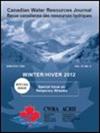21世纪中期纽芬兰极端降水和积雪预估的人为变化
IF 0.9
4区 环境科学与生态学
Q3 WATER RESOURCES
引用次数: 3
摘要
极端降水事件,包括可能最大降水(PMP)和可能最大积雪(PMSA),以及降水(P100)和积雪(以雪水当量表示)的1/100年超额概率(AEP)值;对纽芬兰的SWE100进行了分析,以计算1971-2000年至2041-2070年的预估变化。基于高效风暴的水汽最大化,模拟了不同风暴持续时间的PMP和PMSA。基于每30 a的降水和积雪数据的频率分析,计算了P100和SWE100数据。从北美区域气候变化评估计划(NARCCAP)提供的6个区域气候模式模拟集合中提取所需的气象变量,包括液体和固体降水、可降水量和积雪量,定义在50 × 50 km网格上。预测表明,在未来一段时间内,PMP和P100将增强,PMSA和SWE100将下降。这是第一个量化气候变化对纽芬兰降水极端值特征影响的研究。研究结果可以帮助全省的利益相关者更好地了解全球变暖对极端气象事件的影响。这样的理解是建立弹性和理解该地区标准可能最大洪水分析相关的不确定性的先决条件。本文章由计算机程序翻译,如有差异,请以英文原文为准。
Mid-21st century anthropogenic changes in extreme precipitation and snowpack projections over Newfoundland
Abstract Extreme precipitation events, including probable maximum precipitation (PMP) and probable maximum snow accumulation (PMSA) and 1/100 annual exceedance probability (AEP) values for precipitation (P100) and snow accumulation (expressed in snow water equivalent; SWE100) were analyzed over Newfoundland to compute the projected changes from 1971–2000 to 2041–2070. PMP and PMSA of various storm durations were simulated based on the moisture maximization of high efficiency storms. Also, P100 and SWE100 data were calculated based on the frequency analysis of liquid precipitation and snowpack data during each 30-year period. The required meteorological variables, including liquid and solid precipitation, precipitable water content, and snow accumulation, defined over a 50 × 50 km grid, were extracted from an ensemble of six regional climate model simulations provided by the North American Regional Climate Change Assessment Program (NARCCAP). Projections indicated that while PMP and P100 are intensifying in the future period, PMSA and SWE100 are declining. This is the first study which quantifies the impact of climate change on extreme-value characteristics of precipitation in Newfoundland. The results of the study can help stakeholders throughout the province to gain a better understanding of the impact of global warming on extreme meteorological events. Such an understanding is prerequisite to build resiliency and understand the uncertainty related to standard probable maximum flood analysis in the region.
求助全文
通过发布文献求助,成功后即可免费获取论文全文。
去求助
来源期刊

Canadian Water Resources Journal
WATER RESOURCES-
CiteScore
2.90
自引率
5.90%
发文量
17
审稿时长
>12 weeks
期刊介绍:
The Canadian Water Resources Journal accepts manuscripts in English or French and publishes abstracts in both official languages. Preference is given to manuscripts focusing on science and policy aspects of Canadian water management. Specifically, manuscripts should stimulate public awareness and understanding of Canada''s water resources, encourage recognition of the high priority of water as a resource, and provide new or increased knowledge on some aspect of Canada''s water.
The Canadian Water Resources Journal was first published in the fall of 1976 and it has grown in stature to be recognized as a quality and important publication in the water resources field.
 求助内容:
求助内容: 应助结果提醒方式:
应助结果提醒方式:


